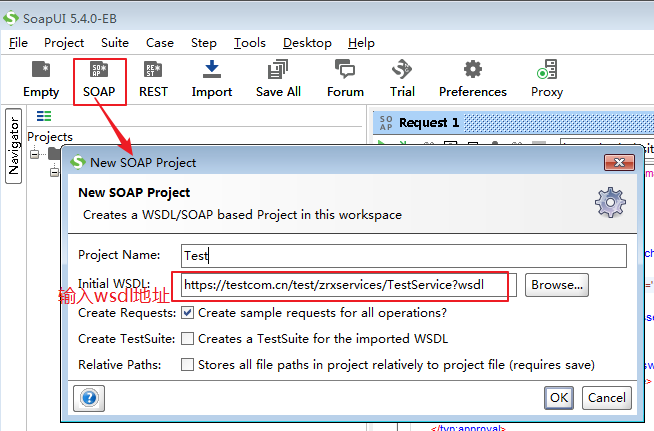场景:合作方服务器接口为webservice 方式,需使用soap方式调用
SoapUI调用测试步骤:
1.创建工程

2.请求接口,可以看到调用接口需要传的参数结构,以及接口返回的具体参数结构

后台使用axis2封装xml信息->请求合作方->解析返回参数:
ServiceClient sender = new ServiceClient(); String serviceUrl = "wsdl地址"; String targetNameSpace = "浏览器访问wsdl地址拿到targetNamespace"; String policyInfoXml = getPolicyInfoXml(orderInfo);// StringBuffer封装xml信息 String opName = "approval";// 要调用的方法 Options options = new Options(); EndpointReference targetEPR = new EndpointReference(serviceUrl); options.setTo(targetEPR); options.setAction(targetNameSpace + "/" + opName); sender.setOptions(options); OMFactory fac = OMAbstractFactory.getOMFactory(); OMNamespace omNs = fac.createOMNamespace(targetNameSpace, ""); OMElement method = fac.createOMElement(opName, omNs); OMElement request = fac.createOMElement("request", omNs); OMElement policyInfo = fac.createOMElement("policyInfo", omNs); policyInfo.setText(getPolicyInfoXml(orderInfo)); OMElement checkCode = fac.createOMElement("checkCode", omNs); checkCode.setText(getCheckCode(policyInfoXml)); OMElement formCommit = fac.createOMElement("formCommit", omNs); formCommit.setText("true"); OMElement productInfo = fac.createOMElement("productInfo", omNs); OMElement classesCode = fac.createOMElement("classesCode", omNs); classesCode.setText("12040100"); productInfo.addChild(classesCode); OMElement userInfo = fac.createOMElement("userInfo", omNs); OMElement password = fac.createOMElement("password", omNs); password.setText(getPassWord()); OMElement userName = fac.createOMElement("userName", omNs); userName.setText(getUserName()); userInfo.addChild(userName); userInfo.addChild(password); request.addChild(checkCode); request.addChild(policyInfo); request.addChild(formCommit); request.addChild(productInfo); request.addChild(userInfo); method.addChild(request); method.build(); // 发送参数至合作商 OMElement resp = sender.sendReceive(method); logger.info("返回响应结果:" + resp); String resultXml = StringEscapeUtils.unescapeXml(resp.toString()); // 解析<ns1:sysMessage> int sysStart = resultXml.indexOf("<ns1:sysMessage>"); int sysEnd = resultXml.indexOf("</ns1:sysMessage>"); if (sysStart == -1 || sysEnd == -1) { logger.error("返回参数错误,<ns1:sysMessage>不存在"); return result; } String sysMessageStr = resultXml.substring(sysStart, sysEnd + "</ns1:sysMessage>".length()).replaceAll("ns1:", ""); // xml->map Map<String, Object> sysMap = XmlUtil.xml2Map(sysMessageStr); //xml2Map转换方法见https://www.cnblogs.com/yfzhou528/p/12147357.html if (sysMap == null || sysMap.size() == 0) { logger.error("返回响应结果-<ns1:sysMessage>解析失败"); return result; } String resultStatus = (String) sysMap.get("resultStatus"); String errorCode = (String) sysMap.get("errorCode"); String errorMsg = (String) sysMap.get("errorMsg"); if (StringUtil.isBlank(resultStatus) || !"S|F".contains(resultStatus)) { logger.error("返回响应结果-resultStatus参数错误"); return result; } // 解析policyInfo携带的xml int rootStart = resultXml.indexOf("<ROOT>"); int rootEnd = resultXml.indexOf("</ROOT>"); if (rootStart == -1 || rootEnd == -1) { logger.error("返回响应结果参数错误,<ROOT>不存在"); return result; } String rootStr = resultXml.substring(rootStart, rootEnd + "</ROOT>".length()); // xml->map Map<String, Object> rootMap = XmlUtil.xml2Map(rootStr); String ApplyId = (String) rootMap.get("ApplyId"); String STATUS = (String) rootMap.get("STATUS"); String APPLYNO = (String) rootMap.get("APPLYNO"); String POLICYNO = (String) rootMap.get("POLICYNO"); String FILE_URL = (String) rootMap.get("FILE_URL");